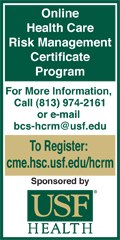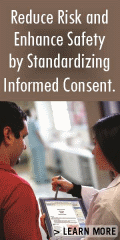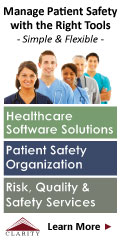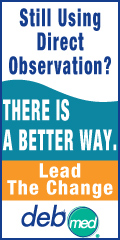 |
 |
 |

July / August 2008

Alternative Dispute Resolution in Healthcare
A Prescription for Increasing Disclosure and Improving Patient Safety
By Gary A. Balcerzak, MS; and
Kathryn K. Leonhardt, MD, MPH
Patient safety and the prevention of medical errors is a mutual goal sought by all in healthcare — patients, providers, and lawyers. Unfortunately, consensus ends when bad outcomes occur. Disputes over "how" and "why" are traditionally resolved through litigation. Because physicians want to avoid the damaging affects of legal actions, they may not disclose to the patient the particulars that led to an adverse event. Patients resort to using malpractice claims in an effort to obtain information that may explain their undesired outcome. One method that has been introduced in healthcare to avoid this litigious approach to communication is Alternative Dispute Resolution (ADR). Results from healthcare systems that are using ADR suggest this approach meets the needs of both patients and providers with the additional benefit of reducing costs, encouraging disclosure, and improving patient safety.
Recent studies of our healthcare system have identified that unanticipated outcomes occur at a high rate, some of which are preventable and due to medical errors (IOM, 2000). When adverse events happen, patients and their families are often devastated and confused. After an unanticipated outcome, patients want to engage in open and honest communication with their physicians (Liebman & Hyman, 2004; Berman; 2002). They want "basic information about the event; assurances that they won't suffer financially because of it; an apology; and prevention of similar events or errors in the future." (Liebman & Hyman, 2004; Hickson, 1992; Gallagher, 2003).
Unfortunately, physicians may not communicate or provide the information in a manner that meets the patients' needs (Liebman & Hyman, 2004; Berman, 2002). Specifically, Foster et al. (2002) found that after an adverse event, patients and their families claim, "their physicians would not listen, would not talk openly, attempted to mislead them and did not warn about long-term medical problems." Eventually, they resort to legal action: one of the most frequent reasons that patients sue physicians is because of ineffective communication (Hickson, 1992; JCAHO, 2007).
Why don't physicians communicate better after an adverse event? For one, physicians have been taught by the traditional legal system to say nothing, admit to nothing, and never accept blame. They fear that disclosing information about an unanticipated outcome may actually bring on litigation. And, the rising rate of litigation is a real concern, with one out of seven physicians being sued each year (Foster et al., 2002). The potential impact of being sued is significant for physicians: the diminishment of their reputation and future livelihood; the financial cost of the malpractice claim; and the affect on their liability and malpractice insurance. Other reasons for not disclosing information include a lack of training in how to disclose, their own emotional shame, and discomfort with difficult conversations (Berman, 2002; Gallagher, Waterman et al., 2003; Gallagher, Garbutt et al., 2006).
Though challenging, disclosing errors is beneficial to patients, providers, and the larger healthcare system. Physicians believe it is morally and ethically the "right" thing to do (Mazor et al., 2004). Professional and regulatory agencies promote disclosure (Liebman & Hyman, 2004; Foster, Schwartz, & DeRenzo, 2002). By improving communication, the enhanced relationship between patient and provider can potentially avoid or minimize the impact of lawsuits (JCAHO, 2007). Once an event is disclosed, a more open discussion can occur among the healthcare team. This allows for the ability to learn from medical errors and to make changes in the system to reduce or eliminate errors and ultimately improve patient safety (JCAHO, 2007).
Different Models of Alternative Dispute Resolution in Healthcare
The public's increased awareness of patient safety and demand for transparency of medical errors, along with the significant cost, complexity, and volume of malpractice cases, has opened the door for utilizing different methods for conflict resolution. Alternative Dispute Resolution (ADR) provides a more effective, timely, and less costly approach for patients and providers to deal with adverse events. Alternative Dispute Resolution refers to any means of settling disputes outside of the courtroom and typically includes arbitration, mediation, early neutral evaluation, and conciliation. Mediators act as neutrals to reconcile the parties' differences before proceeding to arbitration or litigation; arbitrators act as neutral third parties to hear the evidence and decide the case. With escalating court cases, rising costs of litigation, and litigation time delays, more healthcare systems have begun using ADR programs (HG.org).
The "Rush Model" of co-mediation is probably the most referenced example of ADR. In 1995 the Rush Model was developed at Chicago's Rush Medical Center in response to the rapid growth in legal costs and unpredictable rising jury awards in malpractice cases in Chicago. The process begins with the development of a mediation agreement that includes an early exchange of pre-mediation submissions, brief presentations by each side at the initial mediation conference, and caucus procedures. The agreement explains that expenses are shared equally by both sides, describes confidentially, and defines finality (Blatt et al., 2001; Guadagnino, 2004). Mediators are selected by the plaintiff, an inducement for the plaintiff to participate, from a list of trained medical malpractice trial lawyers. A lawyer who traditionally would handle a plaintiffs' medical malpractice case is paired with a lawyer who traditionally defends these cases as co-mediators.
In the first 5 years of the program (1995-2000), 55 malpractice cases, which included medication, diagnosis, and treatment errors, and sometimes resulted in serious injury or death, were mediated. Over 80% of the cases that participated in mediation were successfully resolved within 1 year of the lawsuit being filed and within 3 to 4 hours of mediation (Guadagnino, 2004; Cooley, 2002). In a comparison of mediated cases with similar cases filed in Cook County that were not mediated, the mediated cases were resolved in one-half to two-thirds of the time in which non-mediated cases were settled or came before a jury (Cooley, 2002). Though payouts were of lower amounts, patients were willing to accept the amounts because they were received quickly (Guadagnino, 2004). While Rush Medical Center was concerned that the relatively quick and cost effective co-mediation program might result in an increase in the number of lawsuits, there was actually a slight reduction in the number of lawsuits filed during this time (Cooley, 2002). The "Rush Model" met the self-interests, emotional needs, and concerns of both patients and providers, substantially reduced the spiraling costs and time of traditional methods, produced win-win situations through alternative approaches to settlement, and was popular with both plaintiff and defense counsel (Cooley, 2002).
The Department of Veterans Affairs (VA) has instituted a unique alternative dispute resolution program. It was originally piloted by the Veterans Affairs Medical Center in Lexington, Kentucky in 1987 after seeing an increase in both the number of lawsuits and the size of the awards (Kraman & Hamm, 1999). A proactive policy of full disclosure, even when patients may have had no idea that anything had gone wrong, was implemented. Complete disclosure of the facts surrounding the error or adverse event was provided along with any corrective action that was taken to prevent similar events from happening again. The disclosure included an apology from the chief of staff with full acceptance of responsibility.
An external party or mediator was not used to determine any restitution or settlement. The designated medical center staff negotiated until, "the patient, next of kin, and their attorney, which the VA encourages them to retain, are satisfied with the compensation offered and believe it is fair" (JCAHO, 2007). Compensation included corrective medical or surgical action, increased disability ratings and/or monetary reparation.
Between 1987 and 2003, 170 settlements were negotiated at the Lexington VA, and only three resulted in trials (Kraman & Hamm, 1999). The average payout of these settlements was $16,000 (Weber, 2006). In comparison, a study of federal medical malpractice cases in 1994 and 1995 found that the median amount of an award was $463,000, with an additional $250,000 in associated costs of lawsuit preparation and litigation (Kraman & Hamm, 1999). The number of claims from the Lexington VA was higher than other VA hospitals, but their total payout costs were very low. The Lexington VA approach suggests financial superiority with quicker resolution than traditional litigation, which better meets the needs of patients and providers. The Department of Veterans Affairs instituted this program in all of its medical centers.
Another example of ADR was implemented in 2001 when the University of Michigan Health System adopted a new policy for handling medical malpractice claims. While it was precipitated by the need to reduce the number and size of their claims, the stated policy was based on three principles:
- quick and fair compensation when unreasonable medical care causes patient injury,

- defense of staff and the medical center when care was reasonable and/or when they did not cause injury to the patient, and

- learning from mistakes and patients' experiences (Weber, 2006).
The process includes open and honest discussion of an error or adverse event initiated by medical staff as soon as possible with patients. The staff conveys to the patient their intent to do all they can to help them heal as well as resolve any claim without litigation or expenses. Patients are encouraged to include their attorneys in these discussions.
The disclosure policy has been effective in reducing the number of claims since its inception. Prior to the disclosure policy the average cost per case was $48,000; the current cost is $21,000 (JCAHO, 2007). Attorney fees have been reduced by two thirds. Additionally, the average time to resolve claims has decreased from 1,000 to 300 days (Massachusetts Coalition for the Prevention of Medical Errors, 2006). The University of Michigan Health System risk manager (Boothman, 2006) stated that, "As our success has become more public, out staff reports more close calls and patient injuries — thereby reducing our future claims and increasing actuarial confidence in our future risk. As actuarial confidence grows, the projected cost of our malpractice insurance program drops, freeing up more money for better things like improving patient safety and access and building new facilities."
Another mediation skills model used to manage adverse events is the Pew Demonstration Mediation and ADR project (Liebman & Hyman, 2004). This comprehensive method was implemented in four Pennsylvania hospitals/healthcare systems in 2002. It focuses on improving communication between physicians and patients following a medical error or event including responding to the concerns of patients and their families, learning from these events, and arriving at fair and cost-effective resolution of claims (Liebman & Hyman, 2004).
Their model recommends:
- physicians and other healthcare professionals learn communication skills for disclosure conversations;

- process experts help plan, conduct, and debrief disclosure conversations;

- hospitals allow physicians and hospital staff the time necessary for disclosure conversations;

- all involved parties, including physicians and hospital leaders, offer an apology;

- debriefing and support of healthcare professionals after the error or adverse event; and

- use of mediation to settle potential claims.
In the Pew ADR project, the process of mediation is conducted by a mediator who facilitates discussion that allows individuals to gain a greater understanding of the situation. It allows all participants to request and share information that otherwise may not be shared in the traditional litigation process. Mediation settlements can include provisions that meet patient and family needs such as ensuring that policies or procedures are changed to prevent similar errors or adverse events from occurring again. The parties are encouraged to explore both monetary and non-monetary solutions, whereas court proceedings typically result in judgments only (Gerardi, 2003).
While only two cases were mediated during the 2-year demonstration project, their findings were consistent with other research that sought to understand why patients sue after an adverse event as well as mediation with physicians involving disciplinary complaints (Liebman & Hyman, 2004). In the cases mediated, apologies and the exchange of information, which resulted in changes in policies or practices, were important elements of the settlements.
Other healthcare providers have adopted an ombudsman or internal neutral mediator program to resolve healthcare issues. The ombudsman is a neutral party who is trained to participate in disclosure and other conversations, focusing on the root cause of the issue, creating options and advocating for patients, providers and the organization (Houk, 2002; JCAHO, 2007). In addition, the ombudsman may be responsible for investigation of the error or adverse event, development of plans and protocols to ensure the event does not happen again, training, and education.
The National Naval Medical Center (NNMC) in Bethesda, Maryland was the first acute care hospital to institute an ombudsman program with demonstrated positive results (Houk, 2002). Eighty-two cases were handled by the ombudsman in the first 18 months of the program. All were successfully resolved, the majority within 10 hours with no claims filed on those cases (Houk, 2002). Kaiser Permanente, a national non-profit healthcare provider with 32 medical centers in nine states, established an ombudsman program in 2002, in conjunction with education and training on disclosure. Though Kaiser Permanente was concerned that the program would increase the amount of litigation, that did not occur. The organization believes that effective communication with the patient and family may help actually avoid potential litigation (JCAHO, 2007). As a result of the success of the program, an ombudsman is in place in almost every one of its hospitals and the program is being expanded.
Implications of Alternative Dispute Resolution in Healthcare
The use of ADR methods has resulted in many positive benefits. Health systems that have implemented ADR initially implemented a disclosure process, as disclosure after an adverse event is the necessary first step in the patient-provider communication that leads to mediation. While the disclosure may not prevent or eliminate the use of legal recourse, it can lead to a cooperative and quick settlement process versus a more lengthy, costly, and unpredictable litigation (Cohen, 2004). Problems that are identified through the disclosure and mediation process allow health systems to address patient safety issues. As staff becomes comfortable with a culture of transparency, hospitals become learning organizations that more effectively improve their systems. Financially, ADR may be beneficial as it reduces legal costs on both sides associated with litigation and lower payout amounts (Guadaginino, 2004). Mediation is faster than litigation, providing a quicker resolution with less emotional cost to both patients and providers. By avoiding the ugliness of trials, patients may be able to maintain a respectful relationship with their physician, which is often their desire even after an adverse event (Cohen, 2004).
Barriers and potential negative effects from ADR need to be considered, and further evaluation is warranted. Effective communication and mediation requires training of participants — physicians, hospital staff, and lawyers — which can be time consuming and challenging. Mediation can lead to a more objective assessment of case valuation than litigation, but over time, valuation may rise as mediators become more aware of what cases are settled for (Guadaginino, 2004). With greater disclosure of adverse events, the number of cases requiring mediation (or litigation) may increase and financial costs may be higher.
Conclusion
The current patient safety crisis in healthcare will not be resolved until patients and providers openly discuss the factors that lead to errors and adverse events. In order to improve patient safety, "a more conducive environment is needed to encourage healthcare professionals and organizations to identify, analyze, and report errors without threat of litigation and without compromising patients' legal rights" (IOM, 2000). The process of disclosing errors and adverse events, while the ethical and expected thing to do, is hampered by threats from the traditional legal response. Alternative Dispute Resolution methods offer alternatives to litigation that promote open communication and prompt solutions. Though their use has been limited, the success of existing ADR models is promising. With the potential to promote disclosure, meet the needs of patients, reduce costs, and improve patient safety, ADR in healthcare holds great promise for the future.
Gary Balcerzak is manager of operations improvement and quality improvement at Aurora Health Care in Wisconsin. He has a master-of-science degree and is currently working toward a graduate certificate in mediation and negotiation, both from the University of Wisconsin — Milwaukee. Balcerzak may be contacted at gary.balcerzak@aurora.org.
Kathy Leonhardt is patient safety officer and medical director, care management, at Aurora Health Care. She is a preventive medicine physician, with appointments at the University of Wisconsin-Madison Medical School and Medical College of Wisconsin. Leonhardt recently completed an AHRQ-funded research project on medication safety.
References
Berman, S. (2002, April). Reporting outcomes and other issues in patient safety: An interview with Albert Wu. Journal on Quality Improvement, 28, 197-204.
Blatt, R., Brown, M., & Lerner, J. (2001). Co-mediation: A success story at Chicago's Rush Medical Center. Retrieved November 24, 2007, from http://www.adrsystems.com/news/Co-Mediation.pdf
Boothman, R. C. (2006, March/April). Apologies and a strong defense at the University of Michigan Health System. The Physician Executive, 7-10.
Cohen, J. R. (2004, Spring). Toward candor after medical error: The first apology law. Harvard Health Policy Review, 5, 21-24.
Cooley, J. W. (2002, February — April). A dose of ADR for the health care industry. [Electronic version]. Dispute Resolution Journal.
Foster, H., Schwartz, J., & DeRenzo, E. (2002, June 10). Reducing legal risk by practicing patient-centered medicine. Archives of Internal Medicine, 162, 1217-1219.
Gallagher, T. H., Garbutt, J. M., Waterman, A. D., Flum, D. R., Larson, E. B., Waterman, B. M., et al. (2006, August 14/28). Choosing your words carefully: How physicians would disclose harmful medical errors to patients. Archives of Internal Medicine, 166, 1585-1593.
Gallagher, T. H., Waterman, A. D., Ebers, A. G., Fraser, V. J., & Levinson, W. (2003, February 26). Patients' and physicians' attitudes regarding the disclosure of medical errors. Journal of the American Medical Association, 289(8), 1001-1007.
Gerardi, D. (2003, November). Conflict management training for health care professionals. Accessed on November 24, 2007, from http://www.mediate.com/articles/gerardi4.cfm
Guadagnino, C. (2004, April). Malpractice mediation poised to expand. [Electronic version]. Physician's News Digest.
HG.org. Alternative Dispute Resolution Retrieved March 5, 2008, from www.hg.org/adr
Hickson, G. B., Clayton, E. D., Githens, P. B., & Sloan, F. A. (1992). Factors that prompted families to file malpractice claims following perinatal injury. Journal of the American Medical Assocaition. 287(10), 1359-1363.
Houk, C. (2002, June). The internal neutral: Why doesn't your hospital have one? Retrieved November 24, 2007, from http://www.mediate.com/articles/houk.cfm
Institute of Medicine (IOM). (2000). To err is human: Building a safer health system. L. T. Kohn, J. M. Corrigan, & M. S. Donaldson (Eds.), Washington, D.C.: National Academy Press.
Joint Commission on Accreditation of Healthcare Organizations (JCAHO). (2007). Disclosing medical errors: A guide to an effective explanation and apology. Oak Park, IL: Joint Commission Resources.
Kraman, S. S. & Hamm, G. (1999, December 21). Risk management: Extreme honesty may be the best policy. [Electronic version]. Annals of Internal Medicine, 131(12), 963-967.
Liebman, C. B. & Hyman, C. (2004, July/August). A mediation skills model to manage disclosure of errors and adverse events to patients. Health Affairs, 23, 22-32.
Massachusetts Coalition for the Prevention of Medical Errors. (2006, March). When things go wrong: Responding to adverse events. A consensus statement of the Harvard Hospitals.
Mazor, K. M., Simon, S. R., & Gurwitz, J. H. (2004, August 9/23). Communicating with patients about medical errors: A review of literature. Archives of Internal Medicine, 164, 1690-1697.
Weber, D. O. (2006, March/April). Who's sorry now? The Physician Executive, 6-14.
|
 |
 |
 |


















|
 |



